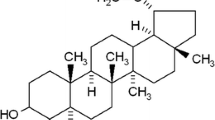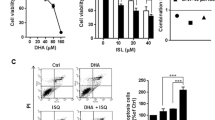Abstract
Docosahexaenoic acid (DHA) plays an important role in suppressing the growth of cancer. In this paper, the synergetic anticancer effect of combination DHA with 5-fluorouracil (5-FU) was investigated in gastric carcinoma cells. We found that DHA inhibited the growth of cultured SGC7901 cells at different concentrations in a dose- and time-dependent manner. Furthermore, the growth-inhibition activities of increasing concentration of 5-FU were markedly enhanced when different doses of 5-FU were administered in the combination with dose as low as 40 μg/ml of DHA. The early phase of apoptosis was increased in DHA- and 5-FU-treated cells. In the case of apoptotic genes expression in the combination-treated cells, BAX mRNA expression increased, whereas FAS, BCL-2, BCL2L12, and CASPASE-9 mRNA expression decreased. These results suggest that DHA strongly enhances the anticancer effect of 5-FU. Moreover, the application of both compounds on gastric cancer cells provides a new potential approach for cancer therapy.



Similar content being viewed by others
References
Adams J. M. Ways of dying: multiple pathways to apoptosis. Genes & Dev. 17: 2481–2495; 2003. doi:10.1101/gad.1126903.
Bougnoux P.; Hajjaji N.; Baucher M. A.; Jourdan M. L.; Goupille C.; Body G.; Floch O. L. Docosahexaenoic acid (DHA) intake during first line chemotherapy improves survival in metastatic breast cancer. Proc Amer Assoc Cancer Res 47: 1237; 2006.
Bradley M. O.; Webb N. L.; Anthony F. H.; Devanesan P.; Witman P. A.; Hemamalini S.; Chander M. C.; Baker S. D.; He L.; Horwitz S. B.; Swindel C. S. Tumor targeting by covalent conjugation of a natural fatty acid to paclitaxel. Clin Cancer Res 7: 3229–3238; 2001.
Calviello G.; Nicuolo F. D.; Serini S.; Piccioni E.; Boninsegna A.; Maggiano N.; Ranelletti F. O.; Palozza P. Docosahexaenoic acid enhances the susceptibility of human colorectal cancer cells to 5-fluorouracil. Cancer Chemother Pharmacol 55: 12–20; 2005. doi:10.1007/s00280-004-0846-6.
Calviello G.; Resci F.; Serini S.; Piccioni E.; Toesca A.; Boninsegna A.; Monego G.; Ranelletti F. O.; Palozza P. Docosahexaenoic acid induces proteasome-dependent degradation of ß-catenin, down-regulation of survivin and apoptosis in human colorectal cancer cells not expressing COX-2. Carcinogenesis 28: 1202–1209; 2007. doi:10.1093/carcin/bgl254.
Cha M. C.; Aldred A.; Stewart C.; Meckling K. A. Dietary docosahexaenoic acid levels influence the outcome of arabinosylcytosine chemotherapy in L1210 leukemic mice. Nutr Cancer 44: 175–181; 2002. doi:10.1207/S15327914NC4402_09.
Danbara N.; Yuri T.; Tsujita-Kyutoku M.; Sato M.; Senzaki H.; Takada H.; Hada T.; Miyazawa T.; Okazaki K.; Tsubura A. Conjugated docosahexaenoic acid is a potent inducer of cell cycle arrest and apoptosis and inhibits growth of Colo 201 human colon cancer cells. Nutr Cancer 50: 71–79; 2004. doi:10.1207/s15327914nc5001_10.
Diep Q. N.; Touyz R. M.; Schiffrin E. L. Docosahexaenoic acid, a peroxisome proliferator-activated receptor—a ligand, induces apoptosis in vascular smooth muscle cells by stimulation of p38 mitogen-activated protein kinase. Hypertension 36: 851–855; 2000.
Ding W. Q.; Lind S. E. Phospholipid hydroperoxide glutathione peroxidase plays a role in protecting cancer cells from docosahexaenoic acid-induced cytotoxicity. Mol Cancer Ther 6: 1467–1474; 2007. doi:10.1158/1535-7163.MCT-06-0608.
Floros K. V.; Thomadaki H.; Katsaros N.; Talieri M.; Scorilas A. mRNA expression analysis of a variety of apoptosis-related genes, including the novel gene of the BCL2-family, BCL2L12, in HL-60 leukemia cells after treatment with carboplatin and doxorubicin. Biol Chem 385: 1099–1103; 2004. doi:10.1515/BC.2004.143.
Gleissman H.; Lindskog M.; Ponthan F.; Elfman L.; Johnsen J. I.; Kigner P. Omega-3 docosahexaenoic acid inhibits neuroblastoma cell growth in vivo. Proc Amer Assoc Cancer Res 47: 1019; 2006.
Horia E.; Watkins B. A. Complementary actions of docosahexaenoic acid and genistein on COX-2, PGE2 and invasiveness in MDA-MB-231 breast cancer cells. Carcinogenesis 28: 809–815; 2007. doi:10.1093/carcin/bgl183.
Kato T.; Pardini R. S. Marine source ω-3 fatty acid, docosahexaenoic acid (DHA), inhibits human colorectal cancer growth through multiple mechanisms depending on the mutational status of p53 protein. Proc Amer Assoc Cancer Res 46: 1046; 2005.
Lee M.; Bae M. A. Docosahexaenoic acid induces apoptosis in CYP2E1-containing HepG2 cells by activating the c-Jun N-terminal protein kinase related mitochondrial damage. J Nutr Biochem 18: 348–354; 2007. doi:10.1016/j.jnutbio.2006.06.003.
Lim K.; Han C.; Xu L.; Isse K.; Demetris A. J.; Wu T. Cyclooxygenase-2-derived prostaglandin E2 activates β-catenin in human cholangiocarcinoma cells: evidence for inhibition of these signaling pathways by ω-3 polyunsaturated fatty acids. Cancer Res 68: 553–560; 2008. doi:10.1158/0008-5472.CAN-07-2295.
Newmeyer D. D.; Fergusson M. S. Mitochondria: releasing power for life and unleashing the machineries of death. Cell 112: 481–490; 2003. doi:10.1016/S0092-8674(03)00116-8.
Ng Y.; Barhoumi R.; Tjalkens R. B.; Fan Y. Y.; Kolar S.; Wang N.; Lupton J. R.; Chapkin R. S. The role of docosahexaenoic acid in mediating mitochondrial membrane lipid oxidation and apoptosis in colonocytes. Carcinogenesis 26: 1914–1921; 2005. doi:10.1093/carcin/bgi163.
Okamura M.; Kobayashi M.; Suzuki F.; Shimada J.; Sakagami H. Induction of cell death by combination treatment with cisplatin and 5-fluorouracil in a human oral squamous cell carcinoma cell line. Anticancer Res 27: 3331–3337; 2007.
Scorilas A.; Kyriakopoulou L.; Yousef G. M.; Ashworth L. K.; Kwamie A.; Diamandis E. P. Molecular cloning, physical mapping, and expression analysis of a novel gene, BCL2L12, encoding a proline-rich protein with a highly conserved BH2 domain of the Bcl-2 family. Genomics 72: 217–221; 2001. doi:10.1006/geno.2000.6455.
Schley P. D.; Brindley D. N.; Field C. J. (N-3) PUFA alter raft lipid composition and decrease epidermal growth factor receptor levels in lipid rafts of human breast cancer cells. J Nutr 137: 548–553; 2007.
Sorreta A. G.; Stafford J.; Kolenic N.; Stafford S.; Horn J. V.; Rogers K. R.; Burke J. K.; Pardini L.; Pardini R. S. The dietary effect of varying ratios of omega-6 to omega-3 and a combinational study of omega-3 enriched diets with Taxotere® on hormone refractory prostate cancer cell line PC-3 growth in vivo. Proc Amer Assoc Cancer Res 47: 914; 2006.
Stegh A. H.; Kim H.; Bachoo R. M.; Forloney K. L.; Zhang J.; Schulze H.; Park K.; Hannon G. J.; Yuan J.; Louis D. N.; DePinho R. A.; Chin L BCL2L12 inhibits post-mitochondrial apoptosis signaling in glioblastoma. Genes Dev 21: 98–111; 2007. doi:10.1101/gad.1480007.
Wolff A. C.; Donehower R. C.; Carducci M. K.; Carducci M. A.; Brahmer J. R.; Zabelina Y.; Bradley M. O.; Anthony F. H.; Swindell C. S.; Witman P. A.; Webb N. L.; Baker S. D. Phase I study of docosahexaenoic acid-paclitaxel: a taxane-fatty acid conjugate with a unique pharmacology and toxicity profile. Clin Cancer Res 9: 3589–3597; 2003.
Wu M.; Harvey K. A.; Ruzmetov N.; Welch Z. R.; Sech L.; Jackson K.; Stillwell W.; Zaloga G. P.; Siddiqui R. A. Omega-3 polyunsaturated fatty acids attenuate breast cancer growth through activation of a neutral sphingomyelinase-mediated pathway. Int J Cancer 117: 340–348; 2006. doi:10.1002/ijc.21238.
Author information
Authors and Affiliations
Corresponding author
Additional information
Editor: J. Denry Sato
Rights and permissions
About this article
Cite this article
Zhuo, Z., Zhang, L., Mu, Q. et al. The effect of combination treatment with docosahexaenoic acid and 5-fluorouracil on the mRNA expression of apoptosis-related genes, including the novel gene BCL2L12, in gastric cancer cells. In Vitro Cell.Dev.Biol.-Animal 45, 69–74 (2009). https://doi.org/10.1007/s11626-008-9154-5
Received:
Accepted:
Published:
Issue Date:
DOI: https://doi.org/10.1007/s11626-008-9154-5




